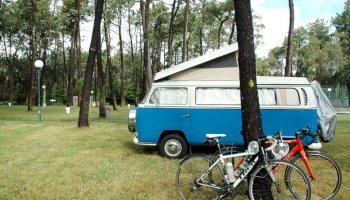Castros and dolmens are ancient symbols that have shaped Galician identity and history. Therefore, I believe that if you are visiting the Costa da Morte, you should visit these megalithic monuments – two of the most important in Galicia and discover many interesting things about our past.
Visiting a castro is always somehow emotive because it transports us directly to the Celtic past, so important in Galician culture. I have always been struck by the geographical similarities that exist between areas as remote as Galicia, the French Brittany or Ireland.
The Castro de Borneiro is easily accessible and on the same road there is a parking space. From there you only have to walk about 300 meters to reach the castro. It is known as A Cidá or A Cibdá, that is, the city and is especially important because it is one of the few that was never occupied by the Romans – at least that is what it is said.

It is a large castro, with about forty houses surrounded by a moat and two defensive walls to protect against enemy attacks. It is located in a high area, in the middle of the forest, and itwas inhabited between the 3rd and 2nd centuries before Christ.
The visit is free, in fact it is in the middle of nature, not even surrounded by a wall, and although there are some explanatory signs, it is true that some more information would be nice. But the area is wonderful and from the historical point of view, it is an exceptional place. In addition, there are several marked hiking trails, which help us combine the cultural visit with a walk in the countryside.
One of the longer routes (10 kilometers) is circular and takes you to the Dolmen de Dombate, as well as other points of interest on the way. If you do not feel like walking, you can reach the dolmen easily by car, it is about 2 kilometers.

Legends say that under the dolmens there are fabulous buried treasures, so just imagine what you will see if you visit the Dolmen of Dombate, which is known as “the cathedral of Galician Neolithic “.
If you’ve been to Galicia, chances are you’ve already seen some, but for those who do not know, a dolmen is a type of Neolithic funerary monument. To get an idea, it is believed that the oldest parts of the Dombate Dolmen date back to the year 4000 BC. Dolmens are formed by huge vertical stone slabs, which hold another horizontal slab, as if it were a roof. They are usually collective tombs and, in addition to the importance they have in themselves, they usually are very important for the petroglyphs and cave paintings that can be found. Furthermore, interesting objects such as quartz tips, ceramics or anthropomorphic figures have also been found in them.

If we take into account that each of these rocks can weigh up to 100 tons, it is clear that the construction of a dolmen was a titanic work involving hundreds of people and can be considered as the beginnings of architecture.
The Dombate Dolmen has a tomb of 24 meters in diameter and 1.8 meters in height and is closed by seven vertical slabs. All slabs have engravings and paintings with geometric motifs. Research indicates that iron oxide was used for shades of red and charcoal for blacks.

After many comings and goings that I do not know in detail, an interpretation center and a building were built to protect the monument from its degradation. Personally, having visited many dolmens located in the middle of nature, I find it strange to see it inside a building that, in my opinion, takes away the focus from the actual monument. It seems to me more impressive to see it under the trees, but it is true that the explanation and guided tours (free and very good!) are very interesting. For me, it is perfect to visit first the dolmen in Dombate to understand more about it and then visit one outdoors, such as the dolmen Pedra da Arca located only five hundred meters from the campsite, Camping Sisargas.
These two megalithic wonders are located less than 25 kilometers from Camping Sisargas and a short distance from each other, making it a good excursion for a morning or an afternoon. We recommend to go by car, as the connections by public transport can be difficult. In addition, the excursion can be complemented with a visit to Laxe, only about ten kilometers from there, either to eat or relax on its beautiful beaches. A perfect plan, both for children and adults.






Leave a Reply
Want to join the discussion?Feel free to contribute!